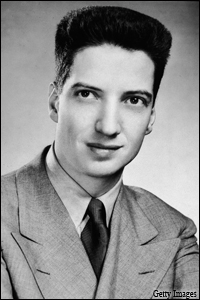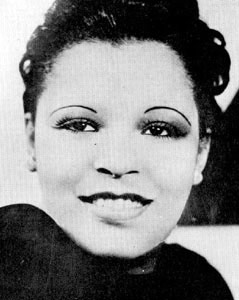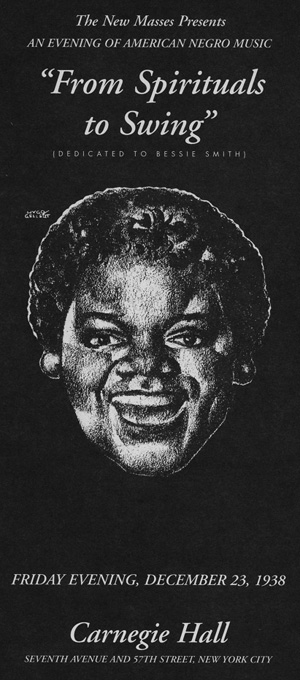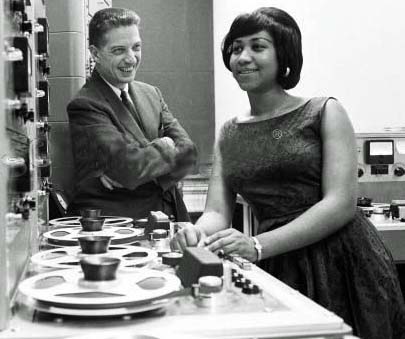
John Hammond and Aretha Franklin at Columbia's 30th Street studio, 1960 publicity photo. Photo courtesy stomp-off.blogspot.
He was a die-hard music lover with an uncanny ability to spot talent and launch careers. For over five decades John Hammond’s unflagging efforts put Billie Holiday, Count Basie and Charlie Christian on the musical map—not to mention Bob Dylan, Bruce Springsteen, Aretha—and a host of others. Beyond his crew cut, his toothy grin and his Ivy League wardrobe, John Hammond was committed to social reform, long before it was a pastime for music industry professionals to latch on to good causes.
Born into Manhattan’s Upper East Side aristocracy Hammond was the greatgrandson of shipping magnate Cornelius Vanderbilt. When he dropped out of Yale in 1932, John decided that he would do something with his personal wealth to make a difference. Jazz became his great cause. Through it he believed he could help right the wrongs of a deeply segregated society.
This week on Riverwalk Jazz, The Jim Cullum Jazz Band with guests Dick Hyman, Topsy Chapman, Harry Allen and others, explore the towering legacy of the man called "the most influential talent scout and music producer in history."
In the early 1930s John Hammond charted a course in music that he would follow for the next 55 years. He funded recording sessions out of his own pocket, handed over cash for train and plane tickets, and was rarely, if ever, paid back. Musicians felt their music was “safe” with John Hammond.
Hammond’s huge appetite for jazz led him to a basement club in Harlem where he discovered the seventeen-year-old Billie Holiday. And it took him on a fifteen-hour ‘detour,' hopping from town to town in a small plane on his way to the West Coast. His destination was Oklahoma City, where he found guitar wizard Charlie Christian.
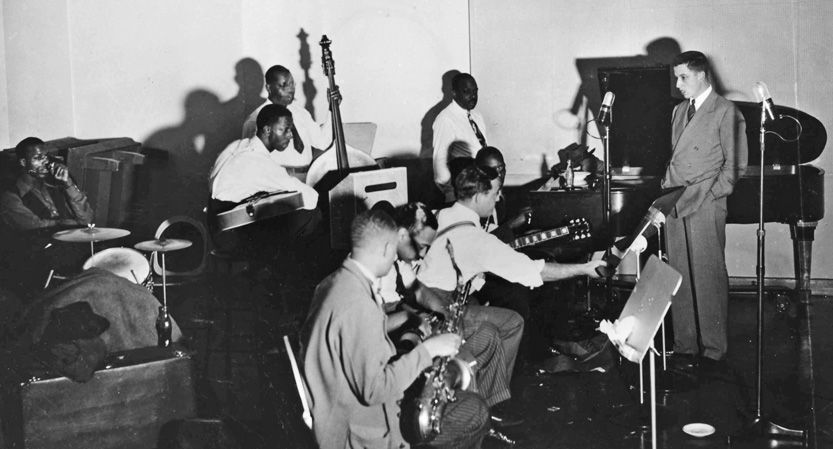
Hammond at a recording session with Buck Clayton, Lester Young, Charlie Christian, Benny Goodman and Count Basie. Photo courtesy Frank Driggs Collection.
John Hammond was more than a hot talent spotter and savvy promoter. He also had the ability to bring musicians together in collaborations that resulted in some of the most acclaimed recordings in jazz history. He said he wanted to “see what musical sparks he could ignite.” In July 1935 he organized a landmark recording session in jazz, with Teddy Wilson on piano, Gene Krupa on drums, and Benny Goodman on clarinet for the first recording by The Benny Goodman Trio.
Within days of this session John Hammond brought Billie Holiday, Teddy Wilson and Benny Goodman together in the studio for the first time in what has been called one of the most “inspired pairings in jazz history.”
Prowling the late-night airwaves, tuning in distant radio signals with his custom-made, high-powered car radio, John Hammond heard a faint signal from Kansas City that caught his attention. It was the Count Basie Orchestra swinging out at the Reno Club in a live transmission. Hammond personally brought the Basie band to the East Coast and national attention.
In 1938 John Hammond crowned the first decade of his career by assembling a once-in-a-lifetime cast of black jazz, blues and gospel artists under one roof—Carnegie Hall. It was his historic Spirituals to Swing concert. Billed as the "Music Nobody Knows," the concert offered performances by bluesman Big Bill Bronzy, who took the bus from his home in Arkansas to be on the concert; and harmonica player Sonny Terry, New Orleans soprano sax legend Sidney Bechet, a trio of boogie woogie piano masters, the Count Basie Orchestra and Sister Rosetta Tharpe singing "Holy Roller" gospel hymns and spirituals.
Though John Hammond has his detractors (no doubt at times for good cause), he will long be remembered for his finely tuned ear, his vision of a more positive future —and his pure joy in the music.
Photo credit for Home Page: John Hammond at Columbia Studios, 1939. Photo courtesy Frank Driggs Collection.
Text based on Riverwalk Jazz script by Margaret Moos Pick © 2010


